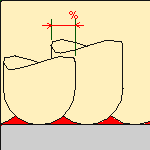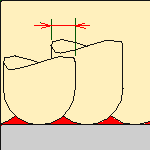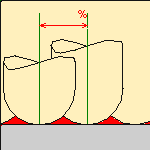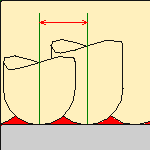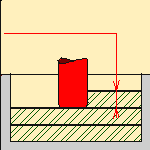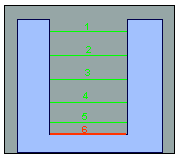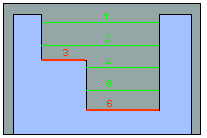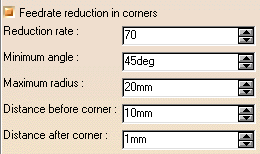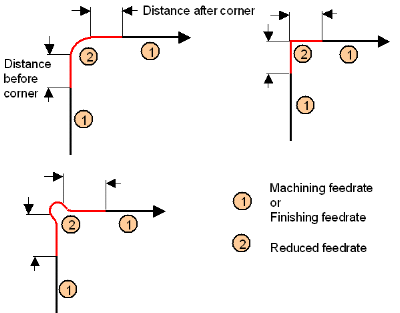Select Prismatic Roughing
![]() then the geometric components
then the geometric components ![]() to
be machined.
to
be machined.
A number of strategy parameters are available for defining:
- Machining criteria
- Radial stepover conditions
- Axial stepover conditions
Specify the tool to be used
![]() and
speeds and feeds
and
speeds and feeds
![]() .
.
You can also define transition paths in your machining operations by
means of NC macros
![]() as needed.
as needed.
Prismatic Roughing: Machining Strategy
Prismatic Roughing: Machining parameters
Tool
path style
Indicates the cutting mode of the operation.
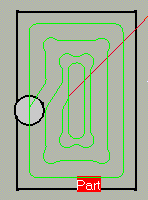
Machining tolerance
Maximum allowed distance between the theoretical and computed tool path.
Consider the value to be the acceptable chord error.
Cutting mode
Specifies the position of the tool regarding the surface to be machined. It
can be:
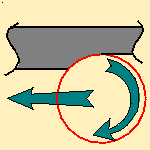 |
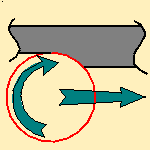 |
| Climb | or Conventional. |
Machining mode
Defines the type of area to be machined:
- By plane: the whole part is machined plane by plane
- By area: the whole part is machined area by area
then
- Pockets only: only pockets on the part are machined
- Outer part: only the outside of the part is machined
- Outer part and pockets: the whole part is machined outer area by outer area and then pocket by pocket.
Helical movement
This parameter is available when the tool path style is set to Helical. It
specifies the way the tool moves in a pocket or an external zone. It can
be:
|
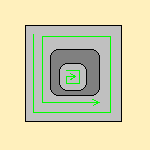
|
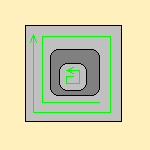
|
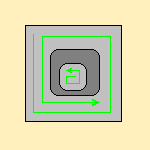
Always stay on bottom
This parameter is available when the tool path style is set to Helical.
When this parameter is set, the linking path between two areas remains in
the plane currently machined.
Part contouring
With part contouring switched on, the tool machines the outside contour of
the part before roughing.
Contouring pass ratio
This parameter is available when the tool path style is set to Back and
Forth. It adjusts the position of the final pass for removing scallops.
This is done by entering a percentage of the tool diameter (0 to 50).
Truncated transition paths
This parameter is available when the tool path style is set to Back and
Forth. It enables the tool to follow the external profile more exactly by
allowing the transition portion of the trajectory to be truncated.
Not truncated:
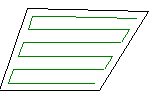 Truncated:
Truncated:
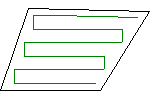
Fully engaged tool management
This parameter is used to manage full material cut when roughing hard material, where the stepover is not always respected and where the tool can
be damaged. This can be avoided by switching to a trochoid motion that
reduces the stepover, or by adding machining planes to reduce the load on
the tool.
Full engagement is detected when:
- more that 75% of the tool diameter is engaged in the material
- or more than 120 degrees of the tool is in contact with the material.
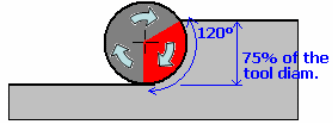
It can be set to:
- None: No management of the tool engagement.
- Trochoid: Adds a trochoid motion in areas where the
stepover is not respected. The trochoid motion is managed by the
Minimum trochoid radius, given in percentage of the tool diameter.
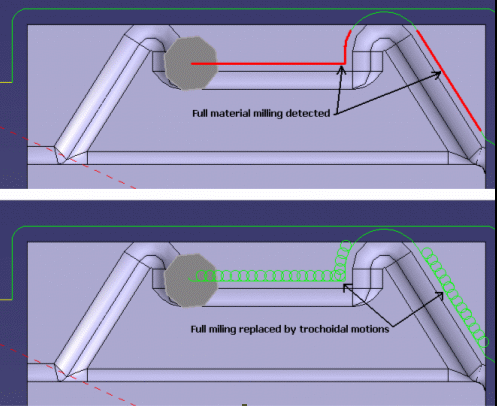
- MultiPass: Adds machining planes in areas where the stepover is not respected. The distance between those additional planes is managed by the parameter Maximum full material cut depth. In previews and replays, a warning is displayed if this cut depth is greater than the Maximum cut depth.
Prismatic Roughing: Radial parameters
Stepover, which can be defined by one of the following.
|
|
|
|
Prismatic Roughing: Axial parameters
Maximum cut depth
Depth of the cut effected by the tool at each pass.
Prismatic Roughing: High Speed Milling parameters
The following parameters are available when the High speed milling checkbox is selected in the HSM tab page.
Corner radius
Specifies the radius used for rounding the corners along the trajectory of
a HSM operation. The tool path is rounded to give a smoother path that can
be machined faster. The minimum value of the corner radius is the radius of
the tool.
Corner radius on part contouring
Specifies the radius used for rounding the corners along the Part
contouring pass of a HSM operation. This radius must be smaller than the
value set for the Corner radius parameter.
Prismatic Roughing: Geometry
You can specify the following geometry:
Part with possible offset.
Rough stock is required.
Check element with possible offset. The check element is often a clamp that holds the part and therefore is not an area to be machined.
Safety plane. The safety plane is the plane that the tool will rise to at the end of the tool path in order to avoid collisions with the part. You can also define a new safety plane with the Offset option in the safety plane contextual menu. The new plane will be offset from the original by the distance that you enter in the dialog box.
Top plane which defines the highest plane that will be machined on the part,
Bottom plane which defines the lowest plane that will be machined on the part,
Imposed plane that the tool must pass through. Use this option if the part that you are going to machine has a particular shape (a groove or a step) that you want to be sure will be cut.
Note that if you wish to use all of the planar surfaces in a part as imposed planes, use the Search/View contextual command to select them. When searching for planar surfaces, you can choose to find either:
- all of the planar surfaces in the part
- or only the planes that can be reached by the tool you are using.
To use planar surfaces as imposed planes:
- Select the planar surfaces
- Select Offset in the contextual menu and enter a value equal
to the machining tolerance plus the offset value on part:
- If the machining tolerance is 0.1 mm and there is no offset on part, enter 0.1 mm as offset for the imposed plane.
- If the machining tolerance is 0.1 mm and the offset on part is 1 mm, enter 1.1 mm as offset for the imposed plane.
This ensures that the imposed planar surface is respected to within the offset and tolerance values.
Start point where the tool will start cutting. There are specific conditions for start points:
- They must be outside the machining limit. Examples of machining limits are the rough stock contour, a limit line, an offset on the rough stock, an offset on the limit line, etc.
- They must be positioned so as to avoid collisions with either the part or the check element. If a start point for a given zone causes a collision, the tool will automatically adopt ramping approach mode.
- The distance between the start point and the machining limit must be greater than the tool radius plus the machining tolerance. If the distance between the start point and the machining limit is greater than the tool radius plus the safety distance, the start point will only serve to define the engagement direction.
- If there are several start points for a given area, the one that is used is the first valid one (in the order in which they were selected) for that area. If there are several possible valid points, the nearest one is taken into account.
- One start point may be valid and for more than one area.
- If a limit line is used, the tool will approach outer areas of the part and pockets in ramping mode towards the outside of the contour. The tool moves from the outside towards the inside of this type of area. In this case, you must define the start point.
Note that if you use a limit line or if you use an inner offset on the rough stock, the start point may be defined inside the initial rough stock. The rules concerning the domain of the contour line or the offset on the rough stock contour line above must be applied.
Whenever possible, the end of the engagement associated to the start point corresponds to the beginning of the sweeping path. If this is not possible, the path will be cut to respect the constraint imposed by the start point.
Inner points (only active if the Drilling mode has been selected in the Macro tab). There are specific conditions for inner points:
- They are usable for pockets only.
- They must be positioned so as to avoid collisions with either the part or the check element. If an inner point for a given pocket causes a collision, the tool will adopt a new inner point generated automatically.
- The inner point must lie inside the pocket or inside the portion of the pocket that is machined.
- If there are several inner points for a given pocket, the one that is used is the first valid one (in the order in which they were selected) for that pocket.
- A point cannot be valid for several pockets.
Limiting contour which defines the machining limit on the part, with the Side to machine parameter.
Automatic horizontal areas detection
When this option is inactive, the only way to ensure that a cutting plane corresponds with an horizontal area is to define an Imposed plane crossing the area. This means that you have to consider the offset on part. This plane applies to the whole part (which is not necessary). If there are several horizontal areas to consider at different levels you have to define all of the corresponding imposed planes.
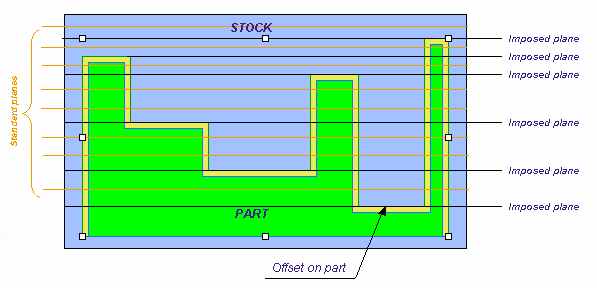
Select this option to:
- detect automatically horizontal areas on the part
- limit the cutting plane effect to these areas
- apply a dedicated offset on the part for these areas.
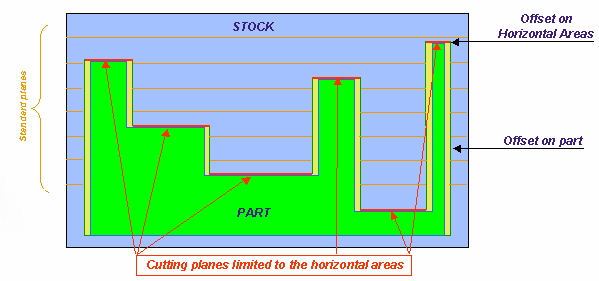
Then enter the value of the offset to apply on the areas (Offset on areas) and define the Maximum angle that can be considered as horizontal. The angle is measured perpendicular to the tool path.
If the machining mode is By area, the tool path will look like this:
If the machining mode is By plane, the tool path will look like this:
The cutting planes in green are the Standard roughing tool paths, the red ones are those computed for the horizontal areas detected.
The computation of horizontal areas is not possible if the part is made
of a cloud of points (STL).
This option is not compatible with the use of offset groups.
Horizontal areas are always defined as pockets (no distinction outer part/pocket). You should use a limiting contour to mill Pocket only or Outer part areas.
Offset
Defines the distance that the tool can overshoot the Position. It is
expressed as a percentage of the tool diameter. This parameter is useful in
cases where there is an island near the edge of the part and the tool
diameter is too wide to allow the area behind the island to be machined.
This parameter can only be used if the Position is inside or outside.
Limit
Definition
Defines what area of the part will be machined with respect to the limiting
contour(s). It can either be inside or outside. In the pictures below,
there are three limiting contours on the rough stock. The yellow areas will
be machined.
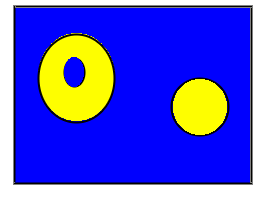
Side to machine: Inside
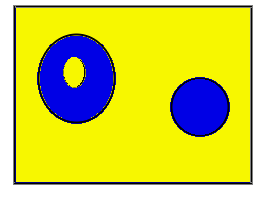
Side to machine: Outside
Prismatic Roughing: Tools
The only supported tools are End Mills.
Prismatic Roughing: Feeds and Speeds
Feedrates and spindle speed can be defined in linear or angular units.
A Spindle output checkbox is available for managing output of the SPINDL instruction in the generated NC data file. If the checkbox is selected, the instruction is generated. Otherwise, it is not generated.
Feeds and speeds of the operation can be updated automatically according to tooling data and the Rough or Finish quality of the operation. This is described in Update of Feeds and Speeds on Machining Operation.
Feedrate Reduction in Corners
You can reduce feedrates in corners encountered along the tool path depending on values given in the Feeds and Speeds tab page: reduction rate, maximum radius, minimum angle, and distances before and after the corner.
Feed reduction is applied to corners along the tool path whose radius is less than the Maximum radius value and whose arc angle is greater than the Minimum angle value.
When machining pockets, feedrate reduction applies to inside and outside corners for machining or finishing passes. It does not apply for macros or default linking and return motions.
Corners can be angled or rounded, and may include extra segments for HSM operations.
Slowdown Rate
You can use Slowdown rate in the Feeds and Speeds tab page to reduce the current feedrate by a given percentage.
In Helical tool paths, the reduction is applied to the first channel cut.
In Back and Forth tool paths, the reduction is applied to the first channel cut and to the transitions between passes.
Combining Slowdown Rate and Feedrate Reduction in Corners
If a corner is included in a Slowdown path, the general rule is that the lowest percentage value is taken into account.
For example, if the Slowdown rate is set to 70 % and Feedrate reduction
rate in corners is set to 50%, the feedrate sequence is:
100%, 70% (entry in slowdown), 50% (entry in corner), 70% (end of corner,
still in slowdown), 100% (end of slowdown).
If Feedrate reduction rate in corners is then set to 75%, the feedrate
sequence is:
100%, 70% (entry in slowdown), 70% (entry in corner: 75% ignored), 70% (end
of corner, still in slowdown), 100% (end of slowdown).
Prismatic Roughing: Macro Data
The following types of macro can be defined on a Prismatic Roughing operation:
For more information on how to save or load an existing macro, please refer to Build and use a macros catalog.
Automatic Roughing Macros
You must select one of the following approach modes to specify how the tool will engage the material:
- Plunge: the tool plunges vertically.
- Drilling: the tool plunges into previously drilled holes. You can change the Drilling tool diameter, Drilling tool angle and Drilling tool length.
- Ramping: the tool moves progressively down at the Ramping
angle. Ramping approach mode applies to pockets but also outer areas in
given conditions:
- If a limit line is used, the tool will approach outer areas of the part and pockets in ramping mode.
- If a lateral approach is not possible (due to the check element), the approach is made in ramping mode.
- Helix: the tool moves progressively down at the ramping angle with its center along a (vertical) circular helix of Helix diameter.
Approach distance
Engagement distance for the selected approach mode.
Axial safety distance
Maximum distance that the tool will rise to when moving from the end of
one pass to the beginning of the next.
Radial safety distance
Distance that the tool moves horizontally before it begins its approach.
Optimize retract
Selecting this checkbox optimizes tool retract movements. This means that
when the tool moves over a surface where there are no obstructions, it will
not rise as high as the safety plane because there is no danger of
tool-part collisions. The result is a gain in time.
Note that in some cases (where areas of the part are higher than the zone you are machining and when you are using a safety plane), the tool may cut into the part. In this case, deselect the Optimize retract checkbox.
Pre-Motion Macros
These are macros that are built by the user using the elementary motions proposed in the Current Macro Toolbox. A pre-motion macro is applied between the rapid motion from safety plane and the automatic macro.
Post-Motion Macros
These are macros that are built by the user using the elementary motions proposed in the Current Macro Toolbox. The post-motion macro between the automatic macro and the rapid motion from safety plane.
